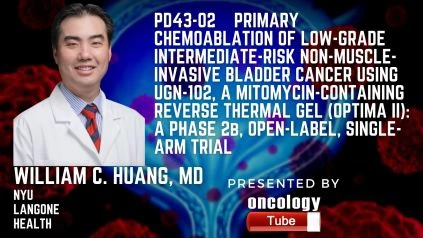William C. Huang, M.D., FACS, Associate Professor and Vice-Chair of Urology at NYU Langone Health, Principal Investigator of the OPTIMA II trial speaks about PD43-02 PRIMARY CHEMOABLATION OF LOW-GRADE INTERMEDIATE-RISK NON-MUSCLE-INVASIVE BLADDER CANCER USING UGN-102, A MITOMYCIN-CONTAINING REVERSE THERMAL GEL (OPTIMA II): A PHASE 2b, OPEN-LABEL, SINGLE-ARM TRIAL.
Link to Abstract:
https://www.auajournals.org/doi/abs/10.1097/JU.0000000000002057.02
Summary –
Goal And Beginnings:
Transurethral resection under general anesthesia is the gold standard of treatment for low-grade intermediate-risk non-muscle-invasive bladder cancer (LG IR NMIBC). LG IR NMIBC is recurring cancer, and patients typically have to have many operations, which can result in substantial postoperative and long-term morbidity. The goal of this research was to see how effective and safe UGN-102, a mitomycin-containing reverse thermal gel, was as a main chemoablative treatment in LG IR NMIBC patients.
Methodologies:
Adult patients with biopsy-proven LG IR NMIBC were enrolled in this prospective, Phase 2b, open-label, single-arm study. In an office setting, patients received 6 once-weekly instillations of UGN-102. The primary outcome was complete response (CR), which was defined as a negative endoscopic examination, negative cytology, and a negative for-cause biopsy three months after therapy began. Patients who obtained CR were followed up every three months for up to a year to see how long their response lasted. The Kaplan-Meier technique was used to calculate the duration of response (DOR). Throughout the research, the participants’ safety was checked.
Findings:
UGN-102 was used to treat 63 patients (mean age 71 years [range 33-96], 60.3 percent male) (intent-to-treat population). Recurrent LG NMIBC was seen in 78 percent of patients, and 44 percent had a prior episode within a year of the present diagnosis. Patients with recurrent NMIBC episodes had an average (range) of 4.4 (1-12) previous NMIBC episodes and a mean (maximum) of 4.0 (13) prior TURBTs. At 3 months, 41/63 (65%) patients had achieved CR, with 39 (95%), 30 (73%), and 25 (61%) patients remaining disease-free at 6, 9, and 12 months following treatment beginning, respectively. At three months, 13/41 (32%) of patients with CR experienced a disease recurrence. The DOR rate was 73 percent after nine months (ie, the probability that a patient will maintain CR for at least 9 months [12 months after treatment initiation] is 73 percent ). The most common adverse effects were dysuria (41%), pollakiuria (21%), hematuria (16%), micturition urgency (14%), urinary tract infection (14%), and tiredness (10% of patients) (11 percent ). One fatality occurred, although it had nothing to do with the therapy.
Outcomes:
Primary chemoablation of LG IR NMIBC with UGN-102 results in a high percentage of disease eradication with promising long-term durability, suggesting that it may be a viable alternative to repeated surgery for these patients. UGN-102 is now being studied in Phase 3 randomized, controlled study for the treatment of LG IR NMIBC. NCT03558503.

